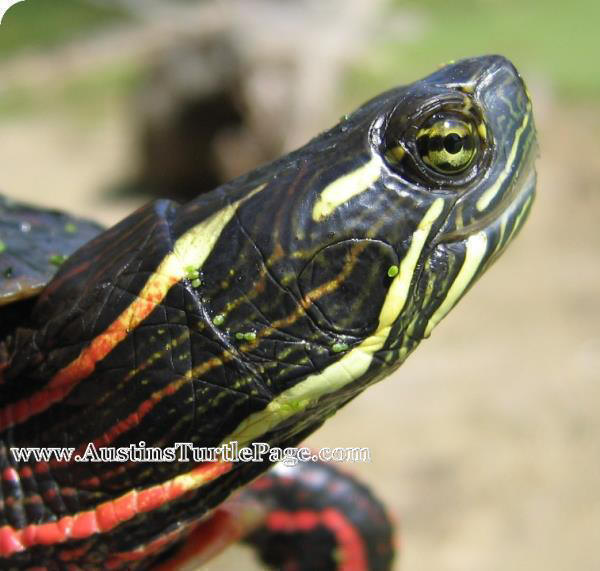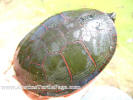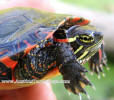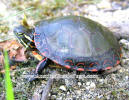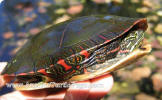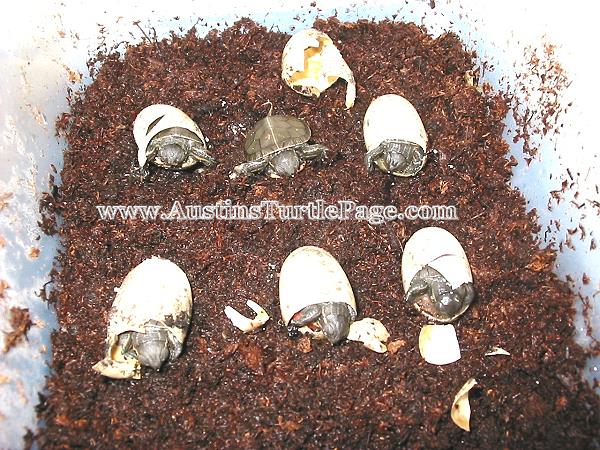|
|
|
|
|
The Midland painted turtle (Chrysemys
picta marginata)
is a small to medium sized turtle capable of reaching straight carapace
lengths of 5 to 9
inches. The body form is ‘classic
basking’ style, very similar to a slider’s.
The carapace is smooth and lightly domed. Its shell ranges from
Midland Painted skin color is usually black to light green; the forearms display broad red lines. The head and throat have prominent yellow lines running from the tip of the nose and mouth downwards across the face. These lines will often turn red as they progress down towards the neck. The upper jaw has pronounced ‘tooth-like’ cusps, and the eyes are generally yellow with a horizontal bar running through the pupil; they often have a yellow line or blotch directly behind the eye. The plastron can range from tan to red and usually displays a large colorful blotched pattern that may take up most of the plastron in some individuals, but can also be greatly reduced in others (western painteds have a more elaborate plastron ‘color burst;’ this is absent in southern & eastern painteds). Note: The plastron in some may be a darker color due to staining from organic compounds in the environment. Male Midlands are generally smaller and less domed than their female counterparts, reaching around 5 inches adult SCL. Males don’t show signs of plastral concavity as is the case with many other turtle species. Males have elongated front claws to aid in courtship and mating rituals. The tails are much longer than females and with the tail fully extended the cloaca will be past the edge of the carapace. Many variations (& intergrades with other painted sub-species) of this sub-species are found in areas where their ranges overlaps one another...leading to a blending of characteristics and frustration when trying to figure out what sub-species you actually have. |
||
|
|
|
|
|
|
|
|
The painted turtle (counting all 4 sub-species) has the largest range of any North American turtle. Ranging from southern Canada and encompassing most of the United States (with the exception of Georgia and Florida) Southern populations tend to be scarce, giving way to larger species of Slider and Cooters. Painted turtles are classified into four distinct sub-species (Midland, Eastern, Southern and Western); the range of the Midland ssp tends to be concentrated most heavily along the great lakes region (Iowa, Michigan, Illinois, Ohio, Indiana, and Wisconsin). |
||
|
|
|
|
|
|
|
|||||
TEMPERATURE RANGE (°F)
Midland Painteds are great beginner turtles. They are hardy turtles and very tame around keepers, which makes them enjoyable since they aren't constantly running and hiding when keepers come near them. Females do get a bit large, up to 9", and can be a strain on housing. Amongst painteds only the southern is smaller, & the midland’s range suggests possible improved cold-tolerance.
Throughout their lives, Midland Painteds are
omnivores
with the strong preference for carnivory
as juveniles. This creates the opportunity for keepers to offer too much protein
RECOMMENDED FEEDING SCHEDULE For the first 6 months of life, feed commercial pellets or meaty foods such as earthworms, crickets or fish once daily, enough to diminish appetite but not gorge the turtle. After 6 months, switch to every other day feeding. Romaine lettuce & other leafy greens may be offered daily for graze at will. Over time adjust diet content & schedule accounting for growth, activity level & appetite. Overfeeding high-protein foods causes rapid growth, shell deformities (pyramiding) & is believed harmful to the liver & kidneys CAPTIVE HABITAT These are avid baskers, so a basking spot is required. UVB lighting is needed as well as a heat lamp over the basking spot. The basking platform will require a heat lamp to maintain daytime temps around 85-90°F and the UVB lighting will provide them with the necessary means to process calcium. A submersible heater is recommended if the water temps fall below the recommend range. They are excellent swimmers and their captive habitat should have a water depth as deep as possible without allowing them to escape. Aquatic substrates are optional, ranging anywhere from a bare bottom to sand, river rock or a fine-to-medium size gravel. RECOMMENDED ENCLOSURE Barring the large size of adult females, single adult male midlands would do well in a 55 gallon aquarium. Single adult females need a minimum of a 125 gallon tank. This allows them plenty of room (quality of life) in addition to plenty of water to assist in good health and filtration. Basking areas can be made of dirt, sand, gravel, smooth rocks or flat rocks, driftwood or anything that will support their weight and is non-abrasive. Adding additional midlands to a habitat requires that you increase the size of the tank accordingly by half (i.e.; 1 male = 55 gallons, 2 males = 75 - 90 gallons, etc). Stock tanks make great alternatives to glass and acrylic aquariums. WATER DEPTH Painteds are accomplished swimmers, For hatchlings, I personally recommend relatively shallow water (4 to 6 inches, you can go deeper after they have gained more strength.) with plenty of structure to rest on should they tire of swimming. Juveniles and adults can be housed in much deeper water as long as a submerged rest area is provided. COMMUNITY HABITAT Midlands make great community inhabitants with other species from the same region and other painteds as well, provided that adequate space is given. Additional males, even of other species, can be problematic in the form of aggression even in large enclosures. Sliders have powerful jaws and can easily injure smaller turtles, so only turtles of comparable size are recommended. |
|||||||
|
|
|
|
|
|
|
|
Midland painteds breed readily in captivity; courtship in this species (and with Slider/Cooter species) consists of the male facing the female and using his elongated claws to tickle or rub her face. This courtship behavior can last for hours or days before the female will finally give into his advances and allow him to mount. Two or three weeks after copulation the female should be palpitated for eggs (you can do this by gently inserting a finger into the carapace in front of the rear legs. If she is indeed gravid, you will feel several lumps. At this time provide a laying area. Provide an area of damp sandy, loamy soil several inches to a foot deep. The female will restlessly search out a suitable area, possibly digging several ‘test nests’ before choosing a spot to lay. The egg chamber is constructed with alternating scoops of the hind feet and once laying starts, the female may take time to rearrange the eggs before covering them back up. If laying is not witnessed, look for recently disturbed ground and carefully look in that area for eggs. If you have doubts that she has laid eggs, just palpitate her again. She should feel considerably lighter. Average clutch size for Midlands ranges between 4 and 12 eggs. This is from my personal experience on incubation, I have had very good results with this method! The easiest way I have found to incubate the eggs is to place them in a plastic container with a mixture of peat moss and cactus succulent potting soil or vermiculite (punch a few drainage holes in the bottom of the container with the eggs to prevent moisture from pooling). The eggs should be buried in the substrate with only the top of the egg exposed (mark the top with a pencil in case they need to be moved for candling) The container is then placed on a wire rack inside of a cooler with a few inches of water at the bottom. Heat is provided by an aquarium heater set to 78 to 83 degrees F. This will also maintain a humidity level of 75 to 85 %( Midland eggs are leathery and will dent or collapse and die if relative humidity is not maintained at 80% or better.) Incubation at 83 F will produce hatchlings in as little as 50 days. 78 F, 55 to 60 days. It is important to keep the substrate choice slightly moist, not damp and the eggs should be covered by a layer of moss or a slanted lid to prevent condensation from dripping directly on the eggs. In the last 2 weeks of incubation watch moisture levels closely, too much and the egg can rupture prematurely. When the eggs start hatching you can help the turtle hatch if it appears to be having trouble doing so on its own. The neonate will slice the egg with the egg tooth and use its front legs to peel back the rest of the egg. If the front legs are all that emerges you can gently remove the shell in front of the neonates head. This can prevent drowning in the egg. The Neonate will remain in the egg for several hours or up to 2 days before absorbing enough of the yolk sac to emerge. It will then promptly bury itself in the substrate to finish absorbing the yolk (they should be then placed in another container inside the incubator to avoid them disturbing any unhatched eggs. They can be introduced to very shallow water as soon as the yolk sac is almost completely healed. They will accept food within 5 to 6 days of absorbing the yolk. Males are produced when incubation temps are maintained at 71.6° - 80.6° F. Females are produced 84° -86 ° F. Mixed genders produced between 80° - 84° F |
|||
|
|
|
|
|
|
|
|
ENCLOSURE A hatchling's captive habitat should mimic that which it would have as an adult. The requirements are the same pertaining to lighting, heat, basking and water depth. Some keepers worry that their turtle might drown in a deep water aquarium and opt to give the hatchling a shallow habitat. That is completely inaccurate. Hatchlings - even fresh day old hatchlings - do quite well in deep water. Hatchlings should be provided with numerous plants (artificial or live) for stability, hiding and climbing. The temperature range for hatchlings and yearlings is a bit different, however, simply because of their high mortality rate. Hatchlings and yearlings should be maintained in the same range as the daytime and basking temperatures listed above, however, their water temps should be kept between 78° and 80°F. DIET They do well on a diet of worms, fish, crickets, augmented by a quality turtle food such as Mazuri and ReptoMin. Veggies should be offered, although some hatchlings do not take to them until they are older. With the exception of live aquatic plant such as Anachris. BEHAVIORAL NOTES: Activity Cycle: Midland Painted are a diurnal species and are most active in the early afternoon after spending the better part of the morning basking to raise their internal temperatures in the spring and fall. In the summer season when water temps are adequate for activity, basking may be limited to short periods at a time or later in the afternoon when activity slows. In the summer Painted turtles are also known to be nocturnal to a degree, actively foraging at night. They can be found on land wandering around occasionally either looking for new habitat or migrating from inhospitable conditions (i.e. drying lakes or marshes). Hibernation throughout much of their range begins in late October/early November and lasts until late May/early April. Personability with Humans: Painted turtles make great pets if you can meet the simple care this species requires. They often exhibit an intimate association with their keeper, be it their charming personalities or their general acceptance of your presence. Long term captives are often first at the glass of the tank, begging for food or just basic interaction. Basking: Midland painteds are avid baskers and bask for extended periods of time in captivity. As long as there are no signs of obvious health problems (swollen eyes, runny nose or gaping) and your turtle is active, eating & willing & able to enter the water, swim & submerge, this behavior should be considered normal. BIBLIOGRAPHY 1.) Turtles of The United States and Canada –Carl H. Ernst, Jeffrey E. Lovich and Roger W. Barbour. Smithsonian Institution Press, Washington and London. ©1994. (Possibly the preeminent natural history text of North American turtles – very highly recommended). 2.) Amphibian and reptiles of the great lakes region- James h Harding |
||
|
|
|
|
|
